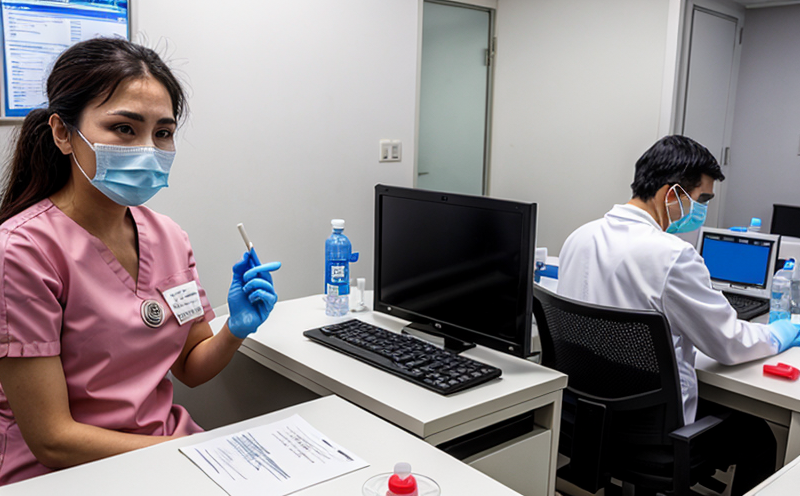Schmallenberg Virus Serological Testing in Ruminants
The Schmallenberg virus (SBV) is a significant threat to ruminant health worldwide. First identified in Europe, SBV has since spread across numerous countries affecting cattle and sheep populations. The virus primarily targets pregnant animals during the first two months of gestation, leading to fetal malformations or abortion. Early detection through serological testing can mitigate the impact by enabling proactive management and control measures.
Serological tests for Schmallenberg virus are highly specific and sensitive, providing a non-invasive method to assess the immune response in ruminants after exposure to SBV. These tests detect antibodies against the virus, indicating past or present infection. The use of serology is particularly valuable for monitoring herds over time, identifying susceptible animals, and evaluating vaccination efficacy.
The testing process involves collecting serum samples from livestock and analyzing them using enzyme-linked immunosorbent assays (ELISAs) or indirect fluorescent antibody tests (IFA). These techniques are chosen for their high specificity and sensitivity in detecting the antibodies produced by the host immune system. Proper sample collection is critical to ensure accurate results, emphasizing the importance of training personnel involved in this process.
The Schmallenberg virus serological test follows strict quality assurance protocols to maintain reliability and accuracy. Samples must be stored at appropriate temperatures and transported under controlled conditions to prevent degradation or contamination. The laboratory adheres to international standards such as ISO 17025 for calibration of instruments and proficiency testing through organizations like the European Union Reference Laboratory (EU-RAL).
Understanding the lifecycle and behavior of SBV is essential in interpreting test results correctly. The virus has a broad host range, including cattle, sheep, goats, and deer, but it does not usually infect humans or wildlife outside of ruminants. This knowledge helps in focusing testing efforts where they are most needed.
Regular monitoring with serological tests can help identify outbreaks early, allowing for prompt implementation of control measures such as vaccination programs, quarantine protocols, and culling of infected animals if necessary. Early detection also supports the development of more effective vaccines and treatments, contributing to global agricultural health.
The Schmallenberg virus serological test is a cornerstone in the management of SBV outbreaks. It plays a crucial role in protecting ruminant populations by providing critical information for herd health management. The timely implementation of control measures based on serological data can significantly reduce the economic impact of SBV, ensuring sustainable livestock production.
Quality and Reliability Assurance
The quality assurance process in Schmallenberg virus serological testing is stringent to ensure accurate and reliable results. The laboratory utilizes calibrated equipment that undergoes regular maintenance and calibration checks according to ISO 17025 standards. Prior to each test run, the instruments are validated using certified reference materials provided by the European Union Reference Laboratory (EU-RAL).
Sample handling is critical for maintaining sample integrity and accuracy. Samples are stored at optimal temperatures to prevent degradation or contamination. The laboratory follows strict protocols for sample collection, transportation, and storage, adhering to best practices outlined in ISO standards.
The testing process itself involves multiple quality control steps. Positive and negative controls are run alongside each test batch to monitor the performance of the assay. Interference checks are performed to ensure that no cross-reactivity or false positives occur. The laboratory participates in proficiency testing programs conducted by EU-RAL, which provides external validation of its analytical methods.
Training and certification of personnel involved in sample handling, testing, and reporting further enhance the reliability of results. Staff undergo continuous education on the latest techniques and standards in virology serology. This ensures that all tests meet high quality assurance criteria, providing accurate and consistent data for decision-making.
Competitive Advantage and Market Impact
- Accurate early detection of Schmallenberg virus infection through serological testing.
- Prompt identification of infected herds to implement control measures effectively.
- Supporting the development of more effective vaccines and treatments for SBV.
- Maintaining herd health by identifying susceptible animals in time.
The Schmallenberg virus serological test offers a competitive advantage by providing critical information that helps livestock owners make informed decisions. Early detection allows for rapid implementation of control measures, minimizing the spread of the virus and reducing economic losses. This proactive approach also supports sustainable livestock production practices, enhancing market reputation.
By participating in international proficiency testing programs, the laboratory ensures its methods are aligned with global standards, providing consistent and reliable results that are trusted by industry stakeholders. The ability to detect SBV early contributes significantly to the market impact of this service, fostering confidence among producers and ensuring compliance with national and international health regulations.
Use Cases and Application Examples
| Application Example | Description |
|---|---|
| Epidemic Monitoring | Monitoring the spread of SBV during an outbreak to identify affected areas. |
| Vaccination Efficacy Testing | Evaluating the effectiveness of SBV vaccines by detecting antibodies in vaccinated animals. |
| Herd Health Management | Identifying susceptible animals within a herd for targeted management strategies. |
| Outbreak Response | Implementing rapid control measures to prevent further spread of SBV during outbreaks. |
- Epidemic Monitoring: Regular serological testing helps in tracking the movement and prevalence of the virus, providing data for strategic decision-making.
- Vaccination Efficacy Testing: Post-vaccination tests can indicate whether the vaccine has induced sufficient immunity against SBV.
- Herd Health Management: Early detection allows for targeted interventions to protect vulnerable animals.
- Outbreak Response: Quick and accurate testing is crucial for implementing containment measures during outbreaks.
The Schmallenberg virus serological test is widely used in various sectors, including livestock production and veterinary medicine. It plays a pivotal role in maintaining herd health by providing critical information on the presence and spread of SBV. This service supports sustainable agricultural practices and contributes to global livestock health management efforts.





